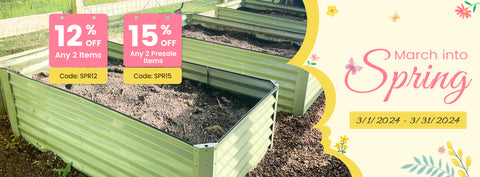Apples are one of the most popular and versatile fruits grown in home gardens, offering a wide range of flavors, textures, and uses. Whether you're a seasoned orchardist or a novice gardener, choosing the right apple tree for your garden is essential for success. In this blog post, we'll explore the different types of apple trees available, including dwarf, semi-dwarf, and standard varieties, and provide guidance on selecting the best option for your garden.The following content also has some reference value for raised garden beds.

Understanding Apple Tree Types
Before delving into the specifics of each apple tree type, it's essential to understand the differences between dwarf, semi-dwarf, and standard varieties:
- Dwarf Apple Trees: Dwarf apple trees are compact in size, typically reaching heights of 6 to 10 feet at maturity. They are ideal for small gardens or container growing and are easier to prune, harvest, and maintain. Dwarf trees also tend to bear fruit earlier than standard varieties, making them a popular choice for home gardeners.
- Semi-Dwarf Apple Trees: Semi-Dwarf apple trees are slightly larger than dwarf varieties, reaching heights of 10 to 16 feet at maturity. They strike a balance between the compact size of dwarf trees and the larger stature of standard varieties, making them suitable for medium-sized gardens or orchards.
- Standard Apple Trees: Standard apple trees are the largest of the three types, reaching heights of 20 to 30 feet at maturity. They require more space to grow and are best suited for larger gardens or commercial orchards. Standard trees produce the most abundant yields but may take longer to bear fruit compared to dwarf and semi-dwarf varieties.
Factors to Consider When Choosing an Apple Tree
When selecting an apple tree for your garden, several factors should be taken into consideration:
- Space Availability: Evaluate the size of your garden or orchard and choose an apple tree type that fits within the available space. Dwarf and semi-dwarf varieties are ideal for smaller gardens, while standard trees require more room to grow.
- Pollination Requirements: Some apple varieties are self-pollinating, meaning they can produce fruit with their pollen alone, while others require cross-pollination from a compatible variety to set fruit. Consider the pollination requirements of the apple trees you're interested in and plant accordingly to ensure successful fruit production.
- Climate and Growing Conditions: Different apple varieties have specific climate and growing condition requirements. Research the cold hardiness, chill hour requirements, and disease resistance of the apple trees you're considering to ensure they are well-suited to your region.
- Desired Fruit Characteristics: Consider your preferences for apple flavor, texture, color, and ripening time when choosing apple varieties. Select varieties that align with your taste preferences and culinary needs, whether you prefer sweet, tart, crisp, or soft apples.

Popular Apple Varieties for Home Gardens
Now that we've explored the different types of apple trees and factors to consider when choosing a variety, let's take a look at some popular apple varieties for home gardens:
Dwarf Varieties:
- Honeycrisp: Known for its sweet, crisp flesh and excellent storage qualities.
- Fuji: A late-season apple with a sweet, juicy flavor and firm texture.
- Gala: A popular dessert apple with a sweet, aromatic flavor and thin skin.
Semi-Dwarf Varieties:
- Golden Delicious: A versatile apple with a sweet, mellow flavor and firm, yellow skin.
- Jonagold: A cross between Jonathan and Golden Delicious, known for its sweet-tart flavor and crisp texture.
- Granny Smith: A tart apple with bright green skin and firm flesh, perfect for baking or cooking.
Standard Varieties:
- Red Delicious: An iconic apple with a sweet flavor and vibrant red skin, often used for fresh eating.
- McIntosh: A classic apple with a tart flavor and tender flesh, ideal for applesauce or baking.
- Empire: A cross between McIntosh and Red Delicious, known for its sweet-tart flavor and crisp texture.
Tips for Planting and Caring for Apple Trees
Once you've selected the right apple tree for your garden, follow these tips for planting and caring for your new fruit tree:
- Choose a sunny, well-drained location with good air circulation for planting.
- Dig a hole that is double the width and slightly deeper than the root ball of the tree.
- Plant the tree at the same depth it was grown in the nursery, and backfill the hole with soil.
- Water the tree thoroughly after planting, and continue to provide regular irrigation during dry periods.
- Spread mulch around the tree's base to retain moisture and suppress weed growth.
- Prune the tree annually to maintain its shape, remove dead or diseased branches, and encourage fruit production.
- Fertilize the tree in the spring with a balanced fertilizer to promote healthy growth and fruit development.

Conclusion
Choosing the right apple tree for your garden is essential for a successful harvest of delicious, homegrown fruit. Whether you opt for a dwarf, semi-dwarf, or standard variety, consider factors such as space availability, pollination requirements, climate, and desired fruit characteristics when making your selection. By following the tips outlined in this blog post and selecting apple varieties suited to your garden's conditions, you can enjoy a bountiful harvest of crisp, flavorful apples for years to come.









